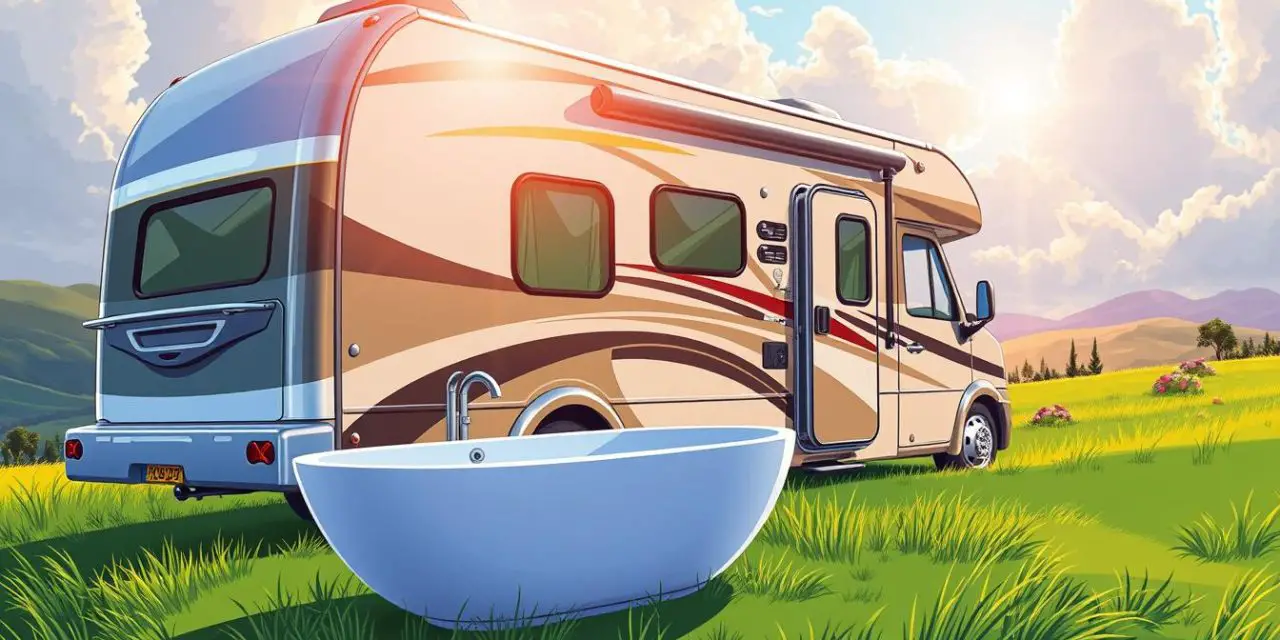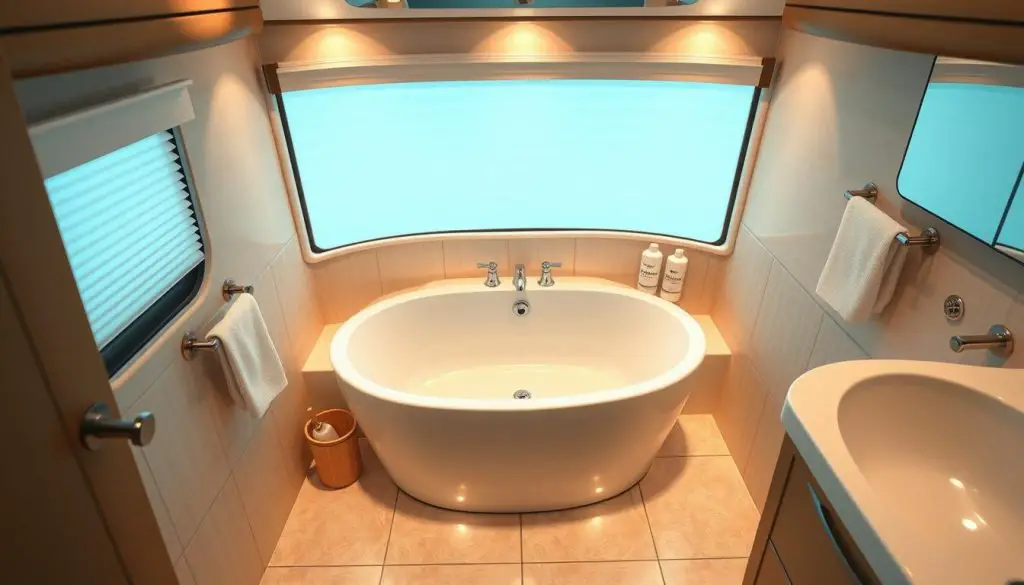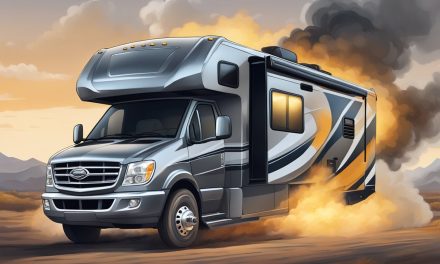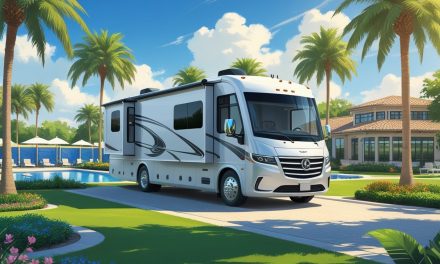Would you like to save this article?
Dreaming of a relaxing soak after a day on the road? Many adventurers wonder if a recreational vehicle can offer that familiar home comfort. The answer is a resounding yes!
Modern motorhomes and trailers do come equipped with bathing facilities. However, these tubs are quite different from their residential counterparts. Space is a precious commodity in any vehicle, shaping the design and function of these amenities.
This guide explores the world of bathing solutions for life on wheels. We will look at available models and important considerations for your specific needs. Whether you’re a family with young children or someone who values a deep soak, options exist.
Finding the perfect fit involves balancing desire with practical limits like weight and water capacity. Our friendly guide will walk you through everything, from installation to creative alternatives.
Key Takeaways
- Many RV models are available with built-in bathing facilities.
- RV tubs are typically smaller and more compact than standard home versions.
- Your choice will depend on personal needs, such as traveling with family.
- Practical factors like space and water usage are critical to consider.
- A wide range of solutions exists, from traditional tubs to innovative alternatives.
- This guide provides a comprehensive overview to help you make the best decision.
Introduction to RV Bathtub Buyer’s Guides
The concept of a bathtub in a vehicle is fundamentally different. These fixtures are engineered for life on the move, not a fixed foundation.
This guide helps you understand these specialized products. We will explore who benefits most from this particular amenity.
Understanding RV Bathtub Concepts
Recreational vehicle tubs are not simply smaller versions of home models. They are designed with strict requirements for mobile living.
Lightweight construction is critical to avoid adding excessive weight. Compact dimensions ensure the fixture fits within the limited bathroom space.
Compatibility with the vehicle’s specific plumbing system is also essential for proper use. These factors define the unique nature of this amenity.
| Feature | RV Bathtub | Residential Bathtub |
|---|---|---|
| Primary Material | Fiberglass or Acrylic | Cast Iron, Steel, or Acrylic |
| Standard Dimensions | Compact, often under 5 feet | Larger, typically 5 to 6 feet |
| Weight Consideration | Extremely high priority | Lower priority |
| Water Capacity | Limited by onboard tanks | Virtually unlimited supply |
Who Benefits from an RV Bathtub?
While many full-time travelers live comfortably for years without one, certain groups find it invaluable. Families with young children are a primary example.
A small, contained tub provides a safe and convenient space for bathing little ones. It simplifies the routine and saves time.
Individuals who rely on baths for therapeutic reasons or deep relaxation also prioritize this feature. For them, the comfort outweighs the space sacrifice.
Evaluating your personal habits is the first step. This ensures your choice of bathroom amenities truly supports your lifestyle.
The Benefits and Drawbacks of RV Bathtubs
Choosing between a shower and tub in a recreational vehicle involves significant trade-offs that impact your entire travel experience. Understanding these balance points helps make informed decisions.
Space Limitations and Layout Considerations
Bathtubs demand considerably more bathroom real estate than shower stalls. This spatial requirement often determines which vehicle classes can accommodate this feature.
Larger Class A motorhomes and fifth wheels typically have room for a proper tub. Smaller Class B and C models usually opt for space-saving shower designs.
| RV Class | Typical Bathroom Size | Bathtub Feasibility |
|---|---|---|
| Class A Motorhome | 35-50 sq ft | Usually accommodates tub |
| Fifth Wheel | 30-45 sq ft | Often includes tub option |
| Class C Motorhome | 15-25 sq ft | Rarely has space for tub |
| Class B Van | 8-15 sq ft | Typically shower-only |
Water Consumption and Energy Usage
Filling even a compact tub consumes substantial water resources. A single bath might use 30-50 gallons from your freshwater tank.
Heating this volume presents another challenge. Standard 6-12 gallon water heaters cannot provide enough hot water for one filling.
“The water and energy requirements make tubs impractical for boondocking, but less concerning at full-hookup campgrounds.”
Soaking Comfort Versus Practicality
Recreational vehicle tubs typically measure 36-46 inches long. This limited room affects the soaking experience for adults.
The practical benefits for bathing children or pets may justify the space sacrifice. However, adults should adjust expectations about luxurious relaxation.
Weigh whether the comfort benefits outweigh the resource demands for your specific travel style.
Can You Get an RV with a Bathtub?
Factory-installed bathing fixtures are available in select motorhome and trailer models. These amenities typically appear in larger fifth wheels and travel trailers designed for extended stays.
Higher-end floor plans often include this feature as standard equipment. Buyers should specifically search for models offering this comfort.
RV-Specific Bathtub Features
Recreational vehicle bathing facilities feature compact dimensions and lightweight construction. Standard measurements range from 36 to 46 inches in length.
Integrated drain systems ensure compatibility with mobile plumbing configurations. The small size makes them ideal for children or pets.
Popular Models and Market Options
The Lippert Better Bath model offers scratch-resistant ABS acrylic construction. It measures 24×36 inches with a right-hand drain.
RecPro’s option provides slightly larger exterior dimensions at 40×24 inches. Its chemical-resistant polymers ensure durability.
Specialty choices include the ICON sit-in step tub for replacement projects. The FerdY Bali offers residential-style options for spacious campers.
These products are available for sale through major RV retailers and online marketplaces. Always verify interior dimensions before purchase.
RV Bathtub Options and Material Choices
When it comes to bathing solutions on wheels, material choices dictate both durability and practicality. Manufacturers prioritize specific construction methods to meet the unique demands of mobile living.
Lightweight Materials and Construction
Recreational vehicle fixtures use high-grade plastics instead of traditional materials. ABS acrylic and fiberglass-reinforced polymers provide strength without excessive weight.
These materials ensure the fixture doesn’t affect the vehicle’s center of gravity. Every design decision focuses on maintaining proper weight ratings while offering reliable performance.
Traditional, Portable, and Inflatable Designs
Portable bathtub options offer innovative solutions for space-limited vehicles. These products work perfectly for families with young children or smaller adults.
One popular portable tub measures 60 x 34 x 27 inches externally. Japanese soaking tub designs provide circular footprints that maximize space efficiency.
Collapsible models like the Stokke Flexi Bath fold flat for convenient storage. This practical option enables chest-deep water immersion without permanent installation.
These portable bathtub solutions feature robust construction with proper drainage systems. They represent a versatile idea for enhancing bathing capabilities beyond standard showers.
DIY Installation and Replacement Considerations
Tackling a DIY bathtub installation requires careful planning and precise measurements from the start. This process demands attention to detail but can be rewarding for hands-on owners.
Measuring Your Space and Tub Dimensions
Before ordering any replacement, measure multiple times. Accurate measurements prevent costly mistakes. Identical replacement parts always fit best and install most easily.
Consider the bathroom layout and available space. Standard aftermarket options are typically 10-12 inches deep, perfect for children and pets.
Step-by-Step Replacement Process
The replacement begins with turning off the water supply. Remove all accessories like shower bars and curtain rods. Carefully detach the old drain and plumbing fixtures.
Next, remove the tub surround and retainer strip. Lift out the old unit and prepare the area by cleaning thoroughly. High-quality mold-resistant silicone caulk creates essential watertight seals.
Install the new drain on the replacement tub before placement. Connect the plumbing and check for leaks immediately. Allow caulk to dry completely before use.
Important considerations: DIY modifications may void manufacturer warranties. The weight of a full tub requires proper floor support. Professional installation is recommended for complex plumbing work.
Alternative Bathing Solutions for RVers
Thinking outside the box opens up a world of creative bathing possibilities for life on the road. These inventive approaches offer flexibility and function without permanent modifications.
Portable and Inflatable Tub Options
Portable designs provide incredible versatility. Inflatable adult bathtubs made from high-density PVC offer a genuine soaking experience. These products often include thermal fusion technology to keep water warm.
Foldable bathtubs for adults collapse flat for easy storage. They are perfect for older children or small adults. Japanese soaking tubs feature a circular footprint that fits neatly inside many shower stalls.
For those desiring luxury, inflatable hot tubs are a fantastic option. These units include built-in heaters, so they don’t rely on your camper’s water heater. They provide a wonderful way to enjoy a long soak under the stars.
Creative Alternatives for Kids and Adults
Resourceful travelers have discovered clever hacks. Some use stock tank tubs, which are livestock watering troughs, for a rustic farmhouse look. Proper drainage is key for this setup.
For a budget-friendly idea, large plastic storage totes can serve as a makeshift bath. Cover them with decorative contact paper for a nicer appearance. This works well for bathing children and pets.
Collapsible bathtubs for kids, like the Stokke Flexi Bath, feature hard plastic sides with drains. They are puncture-resistant and ideal for toddlers. Inflatable kiddie pools also make affordable, fun solutions that fit right in the shower.
These alternatives prove that a satisfying bath experience is possible with a little creativity. They offer practical solutions for families and solo travelers alike.
Conclusion
The great bathtub debate among RV enthusiasts highlights how personal priorities shape camping experiences. Some travelers live comfortably for years without this amenity, while others specifically plan routes to access residential tubs.
Your decision ultimately balances space limitations against bathing preferences. Consider your freshwater tank capacity and water heater capabilities when evaluating options.
Families with young kids often prioritize bathing facilities, while solo travelers may prefer efficient shower setups. Portable solutions offer flexibility without permanent room commitments.
Remember that RV living is about customizing your experience. Whether you choose a fully-equipped bathroom or creative alternatives, prioritize what brings you comfort on the road.







